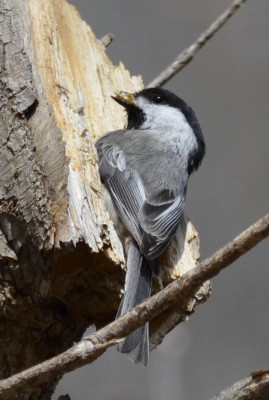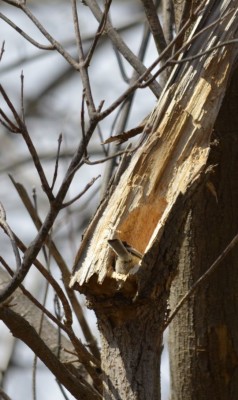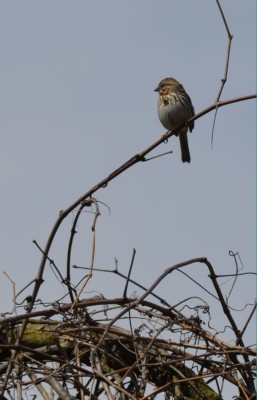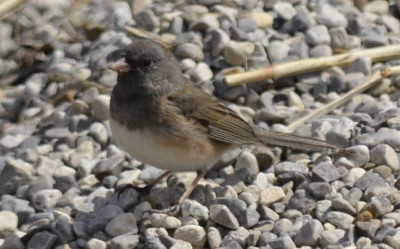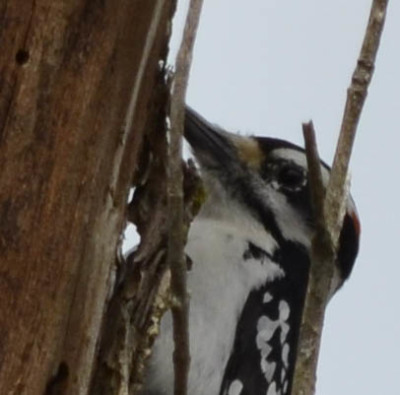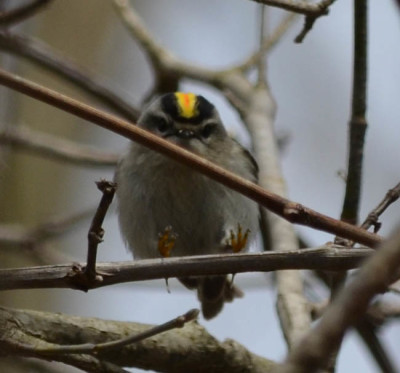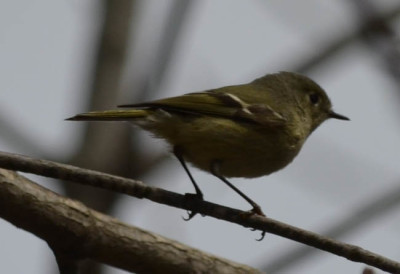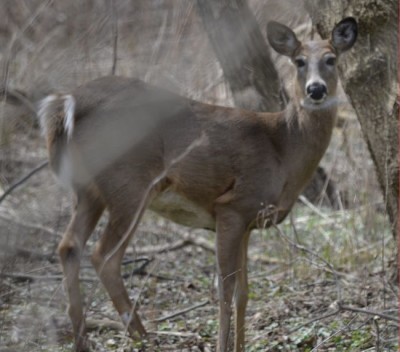In mid-April, as I went for a walk through the woods at the Riverwood Conservancy on the banks of the mighty muddy Credit River, I met many feathered friends and a few furry ones.
The Black-capped Chickadees were setting up house. They will still feed together happily landing on open hands to snitch black oil sunflower seeds. Afterwards, however, they disperse off to their individual spots to sing and build. One Chickadee was energetically pulling out large chunks of soft wood fibres from a recently snapped branch. He was still hard at it when I passed going back fifteen minutes later.
Soft wood makes for easy excavating but does this building site look safe to you?
Is it just me, though, or does it seem like this location would fill with water if he actually tried to nest there? (Chickadees build their nests inside branches in hollowed out cavities. We had a pair raise a brood in a branch of our Crabapple tree one year.)
Song sparrows like to sing high.
Every hundred metres or so, I would hear another Song Sparrow warbling a lusty spring greeting. In song, these sparrows are fairly easy to find as they often perch near the top of a medium sapling or tall bush. They tend to sing fairly steadily so you can track down which tree by listening carefully. Strangely, though, when they are on the ground feeding on seeds I often mistake them for other sparrows. The dark spot on the centre of the heavily streaked chest is a key field mark. The head, with its stripes of chestnut and grey is less obvious as a few sparrows have similar colours.
The Dark-eyed Juncos were still here. Most of these birds nest further north in the coniferous forests. I had expected to see these ones leave soon, but now I’m wondering if some stay and nest right here. I hope to keep an eye out for them over the next month or so to find out. (Update: I have never seen Juncos nesting in Mississauga.)
Woodpeckers, not to be outdone by the chickadees, were hammering on tree trunks to start new nesting cavities but also just to announce their presence with a drum roll. I saw pairs of Downy and Hairy Woodpeckers. There are also pairs of Red-bellied Woodpeckers nesting at Riverwood.
I found it interesting that the Hairy Woodpecker I watched closely for several minutes had a bright yellow fuzzy patch near the base of its bill. I know domestic Budgies have a spot there that changes colour during breeding season and I wondered if this was something similar for the woodpecker.
This is a male Golden-crowned Kinglet: He has the streak of red in the centre of the yellow crown. If you look closely you’ll realize he’s actually still in mid-air, about to land.
While watching a Downy Woodpecker the trees around me were suddenly invaded by a platoon of tiny grey-green birds flitting along the tips of the branches and very rarely the trunks. They had a distinct white stripe above their eye and above that a stripe of black forming a cap. If they tilt their head in your direction a brilliant yellow stripe runs down the centre of the black cap on their head. These were Golden-crowned Kinglets. This striking yellow, black, and white combination helps distinguish them quickly from the Ruby-crowned Kinglets who had not arrived back yet. (Or had they?!)
In a flock of a dozen Golden-crowned Kinglet, this one early Ruby-crowned Kinglet made an almost unnoticed exception.
Unlike the other local birds, the Kinglets were not interested in territories or nests only in insects. The flock is part of many groups migrating north. Only a few, at most, will stay for the summer.
The next creature I met made less noise than the Kinglets despite being massively larger.
This White-tailed deer was feeding quietly about 5 metres from the main footpath. The lighting was dim as the day was rapidly clouding over which makes the photo a bit fuzzy. I took a couple of quick photos then turned my back to try to find an Eastern Phoebe I could hear calling. When I turned around again a minute or two later, the deer had melted away without even a snapping twig to warn me of the departure.
Tune in tomorrow (well, soon anyway!) for Part 2 of this song to spring.
Related Reading
- Rambling through Riverwood Conservancy in April in Mississauga, Ontario: Part Two
- Spring Migrants Surge Along Lake Shore at Arkendo Park, Oakville Ontario
Join In
Have you enjoyed a recent walk in the woods? Please share your adventures with a comment.

